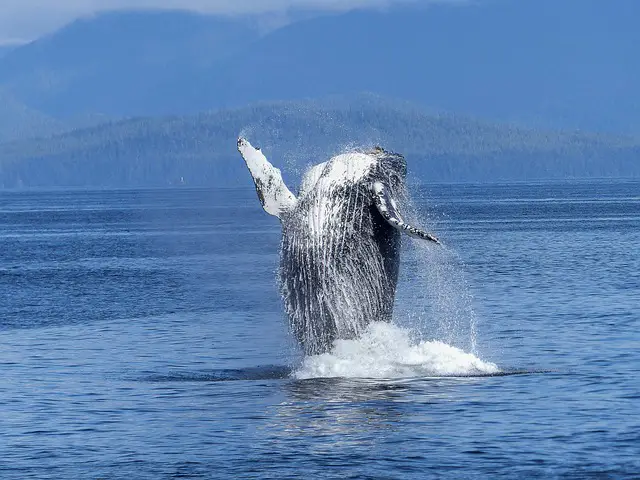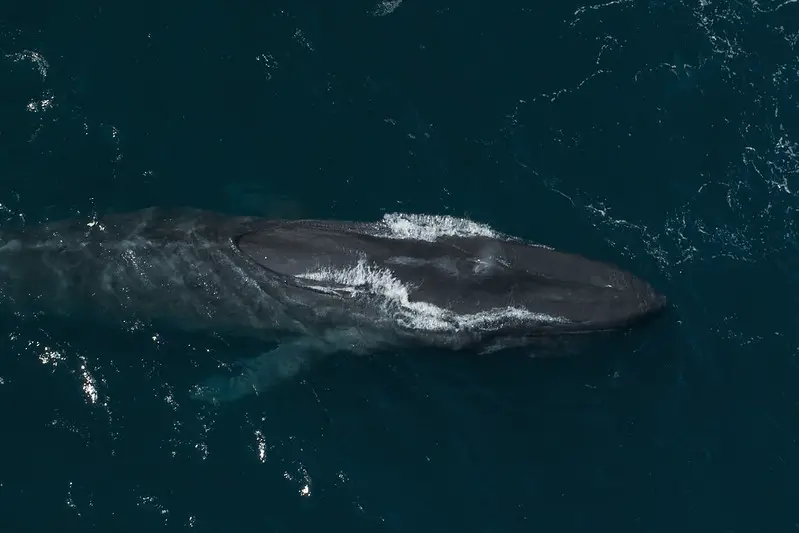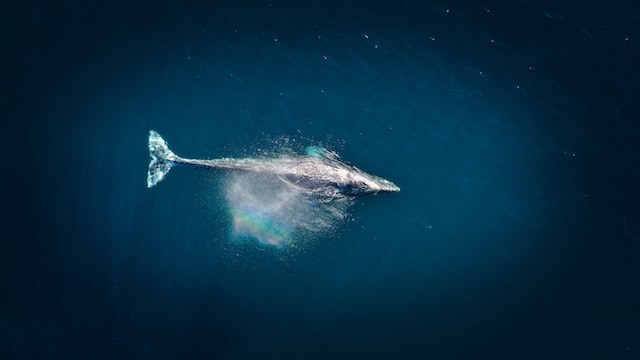The most noticeable difference between the blue whale and the humpback whale is their size; the blue whale is much larger than the humpback. They also differ in hunting methods, with blue whales utilizing filter feeding and humpbacks relying on lunge-feeding for sustenance. And although both belong to the baleen family, the two species can be easily identified by their unique body shapes and coloration patterns.
Blue whale Vs. Humpback whale – Key diffrences
The Appearance of a blue whale compared to a humpback whale
Blue whales have a sleek and streamlined appearance, with a long, slender body and a small dorsal fin. Their skin is a bluish-grey colour, which helps them blend into the water. Humpback whales, on the other hand, have a more robust appearance, with a stocky body and a large, knobbly dorsal fin. They have white markings on their underside that are unique to each individual, making them easy to identify.
The size of a blue whale compared to a humpback whale
The blue whale is the largest animal on the planet, weighing in at around 200 tons. A mature humpback whale, on the other hand, is only about one-tenth that size, coming in at around 20 tons. When you compare the two side by side, it’s easy to see just how massive the blue whale really is!
The diet of a blue whale compared to a humpback whale
A blue whale’s diet consists mostly of krill, whereas a humpback whale’s diet consists of a variety of small fish, crustaceans, and squid. While both whales primarily eat their prey whole, blue whales have been known to filter feed on occasion.
Blue whales are filter feeders, using their baleen plates to strain small creatures like krill and plankton from the water. Humpback whales, on the other hand, are opportunistic feeders, eating a variety of prey including small fish, squid, and krill. Humpback whales are also known for their acrobatic hunting techniques, such as bubble-netting and breaching. Blue whales can eat up to 40 million krill in a day! Humpback whales are known to be more aggressive than blue whales and will often attack other animals, even humans if they feel threatened.
The migration patterns of a blue whale compared to a humpback whale
There are several key ways in which the migration patterns of blue whales and humpback whales differ. For one, blue whales tend to migrate further distances than humpback whales. Additionally, while both species undertake seasonal migrations, blue whales generally migrate more frequently than humpback whales (on a yearly basis). Finally, while the specific migration routes used by each whale species can vary somewhat depending on individual preferences and population dynamics, blue whales generally follow a more linear path during their migrations compared to humpback whales, which often zig-zag or otherwise meander as they travel.
The life expectancy of a blue whale compared to a humpback whale
A blue whale can live up to 90 years, while a humpback whale has an average lifespan of 45 years. Blue whales are also larger than humpback whales, with an average length of 100 feet compared to the latter’s 60-80 feet. Finally, blue whales feed primarily on krill, while humpback whales eat mostly fish.
Songs and vocalizations of a blue whale compared to a humpback whale
Another distinctive difference between blue and humpback whales is their vocalizations. Blue whales are known for their low-frequency songs, which can travel great distances through the ocean. Humpback whales, on the other hand, are known for their complex and varied vocalizations, including songs, grunts, and whistles. Humpback whale songs are also unique to each population, making them a useful tool for researchers studying the species.
Are blue whales related to humpback whales?
Though blue whales and humpback whales both belong to the baleen whale suborder, Mysticeti, they are not closely related. Blue whales are in the family Balaenopteridae, which includes all of the rorquals, while humpbacks are in the family Megapteridae. The two families diverged from a common ancestor about 34 million years ago.
The closest living relative to the blue whale is actually the fin whale, which is also in the family Balaenopteridae. Humpbacks, on the other hand, are more closely related to other baleen whale families such as the Gray Whale Family (Eschrichtiidae), though they too diverged from a common ancestor long ago.
What animal is larger than a humpback whale?
(Image by Brigitte Werner from Pixabay )

The largest animal on the planet is the blue whale. They weigh in at around 200 tons and can grow to be over 100 feet long. The second largest animal is the humpback whale. Humpbacks are much smaller than blue whales, only weighing about 50 tons and growing to be about 60 feet long.
What do humpback whales and blue whales have in common?
Humpback whales and blue whales are both species of baleen whales, which are characterized by having baleen plates instead of teeth for filtering their food. They are also some of the largest animals on Earth, with adult blue whales reaching lengths of up to 100 feet and adult humpback whales reaching lengths of up to 50 feet. Additionally, both species are migratory, traveling long distances between their summer feeding grounds in colder waters and their winter breeding grounds in warmer waters.
Are blue whales friendly?
(Photo By Christopher Michel on Flickr)

Blue whales are not typically considered to be friendly towards humans. They are wild animals and, as such, they should be respected and appreciated from a safe distance. Approaching a blue whale too closely can put both the whale and the human in danger. While they are generally not aggressive towards humans, they are still very large and powerful animals that can unintentionally cause harm. It’s important to observe all guidelines and regulations set by local authorities and to follow best practices for whale watching, such as keeping a safe distance and not disturbing the whales or their environment.
What is the closest living relative to a blue whale?
The closest living relative to the blue whale is the other species of baleen whales. Baleen whales are a group of large whales that include the blue whale, humpback whale, gray whale, right whale, and others. They are believed to have evolved from a common ancestor and are closely related to each other within the order Cetacea, which also includes dolphins and porpoises.
Despite this close relationship, blue whales are considered to be the largest animal on Earth and have many unique adaptations that set them apart from other baleen whales. For example, blue whales have the largest heart of any living animal and their arteries are so wide that a human could swim through them. They are also capable of diving to great depths and can consume hundreds of thousands of calories in a single feeding session. These adaptations, along with their large size, help blue whales thrive in the open ocean, where they feed on small organisms such as krill and small fish.
Are blue whale related to Minke whales?
Yes, blue whales are closely related to minke whales. Minke whales are part of the same family (Balaenopteridae) as blue whales, along with other species such as humpback whales and fin whales. These species are all members of the suborder Mysticeti, which is made up of baleen whales. The relationship between blue whales and minke whales is similar to the relationship between, for example, humans and chimpanzees: they are closely related but belong to different species. They share a common ancestor and have evolved distinct physical and behavioral traits over time.
But based on DNA evidence, scientists have estimated that blue whales and minke whales diverged from a common ancestor approximately 4-5 million years ago. This suggests that they have a close evolutionary relationship, although they have evolved distinct physical and behavioral traits over time. The molecular evidence supports the idea that baleen whales, including blue and minke whales, are closely related and belong to the same family (Balaenopteridae). This family is part of the suborder Mysticeti, which also includes other species of baleen whales such as humpback and fin whales.
What are blue whales and humpback whales hunted for?
Commercial whaling for both species reached its peak in the late 19th and early 20th centuries, and by the mid-1960s, their global populations had been severely depleted. In 1966, the International Whaling Commission banned the hunting of blue and humpback whales, but by then the populations had already been reduced by more than 50% and 90%, respectively.
Today, blue and humpback whales are protected under international law, and hunting them is illegal. Conservation efforts have helped their populations to recover somewhat, but they are still estimated to be only a fraction of their pre-whaling size. It is important to continue to protect these species and their habitats to ensure their survival for future generations.
Are blue whales and humpbacks in danger of being extinct?
Yes, both blue whales and humpbacks are in danger of becoming extinct. The main threat to these whale species is commercial whaling. In the past, large numbers of blue whales and humpbacks were killed for their oil, meat, and other body parts. Today, although commercial whaling is banned in many countries, it still occurs illegally in some areas. This illegal hunting continues to put pressure on blue whale and humpback populations. Climate change is also a threat to these whale species. As the ocean warms, their food sources may become less available or more difficult to find.
How to protect blue whales and humpbacks?
There are several measures that can be taken to protect blue whales and humpback whales:
- International protection: Both species are protected under international law, including the International Whaling Commission’s moratorium on commercial whaling.
- Habitat protection: Protecting the whales’ habitats, such as feeding and breeding grounds, is crucial for their survival. This includes protecting areas from pollutants, overfishing, and the destruction of critical habitats such as mangroves and estuaries.
- Reducing ship strikes: Collisions with ships are a significant threat to blue and humpback whales. Measures such as reducing speeds, rerouting shipping lanes, and improving ship design can help reduce the risk of ship strikes.
- Monitoring and research: Ongoing monitoring and research can help us better understand the threats facing these species and develop effective conservation strategies.
- Public education and outreach: Raising awareness and educating the public about the importance of protecting blue and humpback whales can help to mobilize support for conservation efforts.
- Enforcing regulations: Effective enforcement of international and national regulations is critical for ensuring that the protections for blue and humpback whales are upheld.
By implementing these measures, we can help to protect these magnificent creatures and ensure their survival for future generations.
Featured Image By – Photo by Venti Views on Unsplash









